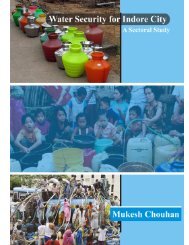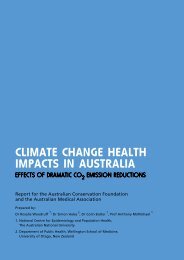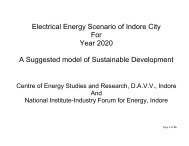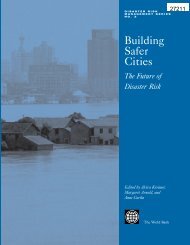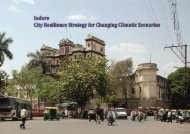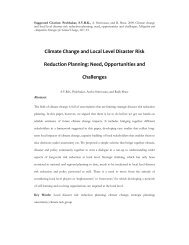Mapping climate vulnerability and poverty in Africa - CGSpace Home
Mapping climate vulnerability and poverty in Africa - CGSpace Home
Mapping climate vulnerability and poverty in Africa - CGSpace Home
You also want an ePaper? Increase the reach of your titles
YUMPU automatically turns print PDFs into web optimized ePapers that Google loves.
mean<strong>in</strong>gful way, so current ra<strong>in</strong>fall CV <strong>and</strong> changes <strong>in</strong> ra<strong>in</strong>fall amounts were used as proxies<br />
for future conditions. We also carried out cont<strong>in</strong>ent-wide analyses of the possible changes <strong>in</strong><br />
probability of season failure, for the cropp<strong>in</strong>g areas of sub-Saharan <strong>Africa</strong>. For that analysis,<br />
we omitted both very dry <strong>and</strong> very wet areas. These various analyses are described below.<br />
4.1 Data <strong>and</strong> analysis<br />
For look<strong>in</strong>g at different scenarios of <strong>climate</strong> change to 2050, the data set TYN SC 2.0 was<br />
used, k<strong>in</strong>dly supplied by its orig<strong>in</strong>ator, Timothy D Mitchell (Mitchell et al., 2004). The<br />
variables used from this data set were the diurnal temperature range, precipitation <strong>and</strong><br />
average daily temperature on a monthly basis. The data cover the global l<strong>and</strong> surface at a<br />
resolution of 0.5 degrees latitude <strong>and</strong> longitude, <strong>and</strong> cover the period 2001 to 2100. There<br />
are 20 <strong>climate</strong> change scenarios <strong>in</strong> the complete data set. The <strong>climate</strong> change scenarios are<br />
made up of all permutations of five Atmosphere-Ocean General Circulation Models<br />
(AOGCMs) (HadCM3, CSIRO2, CGCM2, PCM, ECHam4) <strong>and</strong> four SRES scenarios (A1FI,<br />
A2, B1, B2). The five models used <strong>in</strong> this data-set (see Table 1) were among the set of stateof-the-art<br />
coupled <strong>climate</strong> models used by the IPCC (2001) <strong>in</strong> the Third Assessment Work<strong>in</strong>g<br />
Group 1 Report. A summary of their features may be found <strong>in</strong> IPCC (2001). The month-tomonth<br />
<strong>and</strong> year-to-year variations are superimposed on top of the averaged <strong>climate</strong> changes<br />
taken from the models; these are taken from the gridded observations <strong>in</strong> a companion dataset,<br />
CRU TS 2.0 (New et al., 2002). The two data sets together thus provide complete timeseries<br />
for the period 1901-2100.<br />
Details of the SRES scenarios can be found <strong>in</strong> IPCC (2000), <strong>and</strong> these are summarized <strong>in</strong><br />
Table 2. The “A” scenarios have more of an emphasis on economic growth, the “B”<br />
scenarios on environmental protection. The “1” scenarios assume more globalisation, the “2”<br />
scenarios more regionalization. The SRES scenarios have come <strong>in</strong> for some criticism, partly<br />
to do with the fact that the projections for human population have become out-of-date<br />
surpris<strong>in</strong>gly rapidly. While some have criticized the population <strong>and</strong> economic details, the<br />
scenarios are generally <strong>in</strong>ternally consistent <strong>and</strong> constitute a very useful set of st<strong>and</strong>ards, <strong>and</strong><br />
the range of future greenhouse gas emissions is undisputed (Tol et al., 2005).<br />
21



